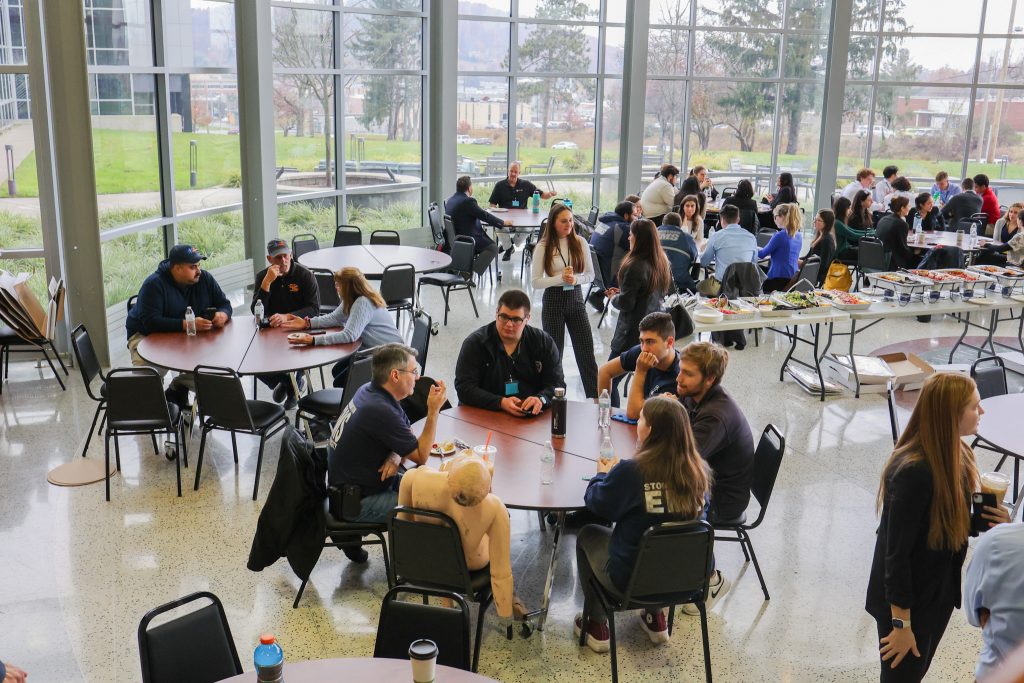Students, medical experts and educators gathered for a weekend of interactive learning and networking at the Harpur’s Ferry Emergency Medical Service (EMS) Conference.
The 11th annual EMS Conference, which was held in the Innovative Technologies Complex this past Saturday and Sunday, offered student emergency medical technicians (EMTs) presentations, activities and demonstrations. It started with a brief speech by Dr. Jim Rodriguez, a specialist in emergency medicine and the conference’s keynote speaker, and participants later split up to attend various presentations. Along with attending lectures, students participated in mock emergency scenarios and simulations to develop their emergency medicine skills.
Harpur’s Ferry, Binghamton University’s student-run ambulance service, provides free, emergency medical care to the campus and the Greater Binghamton community. Founded in 1972 by students with few resources and one vehicle, Harpur’s Ferry has since grown into a fully-fledged, widely recognized EMS service. Unlike other collegiate ambulance services, Harpur’s Ferry staffs all of their ambulances with advanced life support.
Their EMS conference, which began in 2012 as a small internal training session for Harpur’s Ferry members, has since expanded to host several collegiate and local EMS agencies from throughout the state. Since COVID-19, the conference has adapted hybrid and virtual options.
Speakers presented on emergency medicine, including treating chest pain and burn victims. Using case studies, theoretical models and hands-on skill-building exercises, the speakers also lectured on issues like toxicology, sexual assault and obstetrical emergencies.
One lecture was presented by Ben Barone, a paramedic, and Rebecca Monachelli, an advanced emergency medical technician (AEMT). They spoke about current and developing technology in EMS and cited EMS Agenda 2050, a theoretical case study using hypothetical medical technology from the year 2050. They discussed how current technology, including telemedicine and wearable devices for measuring vitals like smartwatches, could be adapted and developed even further.
“The picture we painted for 2050 [is] not that far away,” Monachelli said. “Don’t be surprised if we see something like this soon.”
Along with medical lectures, speakers focused on issues like diversity, sexual harassment and mental health. Howard Huth, a paramedic, spoke about the distinction between ethics and morals in the medical field and reiterated the need for professionalism among EMTs. Jessica Merkel-Keller, a psychiatrist, discussed the importance of self-care, particularly for EMTs whose shift-based work often leads to anxiety, trauma and sleep deprivation.
Jade Dowswell and Régina Nguyen, coordinators from the UDiversity Educational Institute, presented about incorporating inclusive practices into EMS. Other speakers included Ryan Greenberg, the director of the New York state EMS Bureau, who gave a presentation on his work and state legislation.
Jack Flanagan, a junior majoring in biology, described how the conference provided student EMTs experience and education.
“I think [the conference] is really fun,” Flanagan said. “It’s a good opportunity for all of the members of Harpur’s Ferry. It’s a really good training opportunity and a very good learning experience.”
For attending lectures, student EMS providers received continuing medical education (CME) credits needed for recertifications. CME credits, gained by completing 45 to 55 hours of refresher training and skills proficiency verification, allow EMS providers, like EMTs, to renew their medical certifications.
AEMT Michelle Elsmore and Emergency Medical Technician Basic (EMT-B) Zachary Evans, the conference coordinators, expanded on additional benefits attendees received.
“Given that many students have plans to pursue careers outside of EMS, we believe this conference will provide them with skills that will translate into a multitude of different fields,” they wrote in an email. “Learning how to be compassionate toward others, how to maintain composure in a hectic situation and recognizing when we are struggling internally are just a few examples of ways in which we can better ourselves not just as EMS professionals, but as people in every facet of life.”



